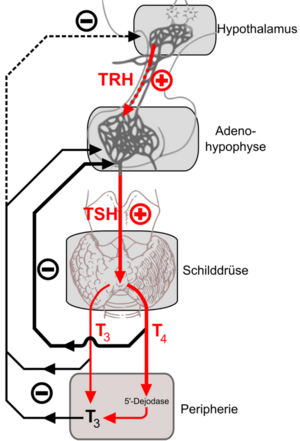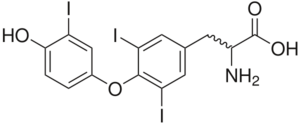Examination for thyroid diseases
From WikiLectures
This article has been translated from WikiSkripta; ready for the editor's review.
Indicators of thyroid dysfunction[edit | edit source]
TSH in serum[edit | edit source]
- Its concentration is inversely proportional to the concentration of [[T4]] ,
- assuming normal function of the hypothalamic-pituitary axis reflects the level of T 4 ,
- Significantly increased: primary hypothyroidism,
- Sometimes produced modified - you can also find
- The method of first choice in case of suspected primary hypothyroidism or hyperthyroidism,
- Monitoring of T4 substitution therapy ,
- Is investigated in hypercholesterolemia and hyperprolactinemia.
Function test with TRH[edit | edit source]
- Reflects TSH secretion
- in central hypothyroidism, in TSH-producing tumors.
Total thyroxine (TT4) and free (FT4) in serum[edit | edit source]
- Current secretion indicators
- FT4 indicates the availability of the hormone by tissues
- free thyroxin index – FTI
- Prior to the treatment of hyperthyroidism, TSH secretion may still be suppressed in the long term.
Triiodothyronine total (TT3) and free (FT3) in serum[edit | edit source]
- High levels of T3 autonomic hyperactivity of the gland
- Indications - examination of hyperthyroidism, severity of primary hypothyroidism, differential diagnosis of low TSH levels.
Reverse T3 (RT3)[edit | edit source]
- Indirect indicator of T4 to T3 conversion,
- Examination of unknown causes of low TT3 or TT4.
Serum Thyroglobulin (TG)[edit | edit source]
- Indicator of TG release from the active, inflammatory or tumor gland,
- Follow-up of patients after thyroidectomy for differentiated ca as a tumor marker - diagnosis of relapse (increasing TG).
α-subunit of hCG[edit | edit source]
- In general, it detects the formation of molecules with this subunit - even TSH.
Calcitonin, serum thyrocalcitonin[edit | edit source]
- Thyroid gland C-cell secretory activity indicator ,
- In the diagnosis of medullary tumors.
Disorders of thyroid hormone transport[edit | edit source]
Serum thyroxine binding globulin (TBG)[edit | edit source]
- Quantitatively the most important carrier,
- High values: genetically, in pregnancy, contraception,
- Low concentrations: malnutrition, malabsorption, hepatic synthesis disorders,
- We examine at T3 and T4 values that do not correlate with the clinical condition.
Prealbumin, transthyretin in serum[edit | edit source]
- The second most important carrier.
Binding capacity of transport proteins, T-uptake[edit | edit source]
- Significance and indications as for TBG, saturate the serum sample with a known concentration of T3 and determine the unbound fraction.
Indicators of autoimmune diseases of the thyroid gland[edit | edit source]
Thyroperoxidase Antibodies (Thyreoperoxidase Antibodies, TPOAb)[edit | edit source]
- Formerly described as antimicrosomal,
- Reveal the presence of an autoimmune process, the possible risk of dysfunction,
- Indications: goiter of unknown etiology, differential diagnosis of hyperthyroidism,
- Postpartum risk screening.
Anti-thyroglobulin antibodies[edit | edit source]
- They reveal the autoimmune process, they can explain incorrect results of TGB determination,
- Monitoring of differentiated thyroid carcinomas.
Antibodies to TSH receptors[edit | edit source]
- They can either stimulate or inhibit,
- Risk of developing Graves' disease, risk of endocrine ophthalmopathy,
- Differential diagnosis of hyperthyroidism.
Links[edit | edit source]
Related articles[edit | edit source]
- Thyroid gland
- Thyroid hormones
- Hyperthyroidism
- Hypothyroidism
- Examination of thyroid function
- Thyroid disease
- Radionuclide examinations of the thyroid gland
- Symptomatic mental disorders in endocrinopathies
References[edit | edit source]
- SCHNEIDERKA, Petr, et al. Chapters from clinical biochemistry. 2nd edition. Prague: Karolinum, 2004. ISBN 80-246-0678-X.




